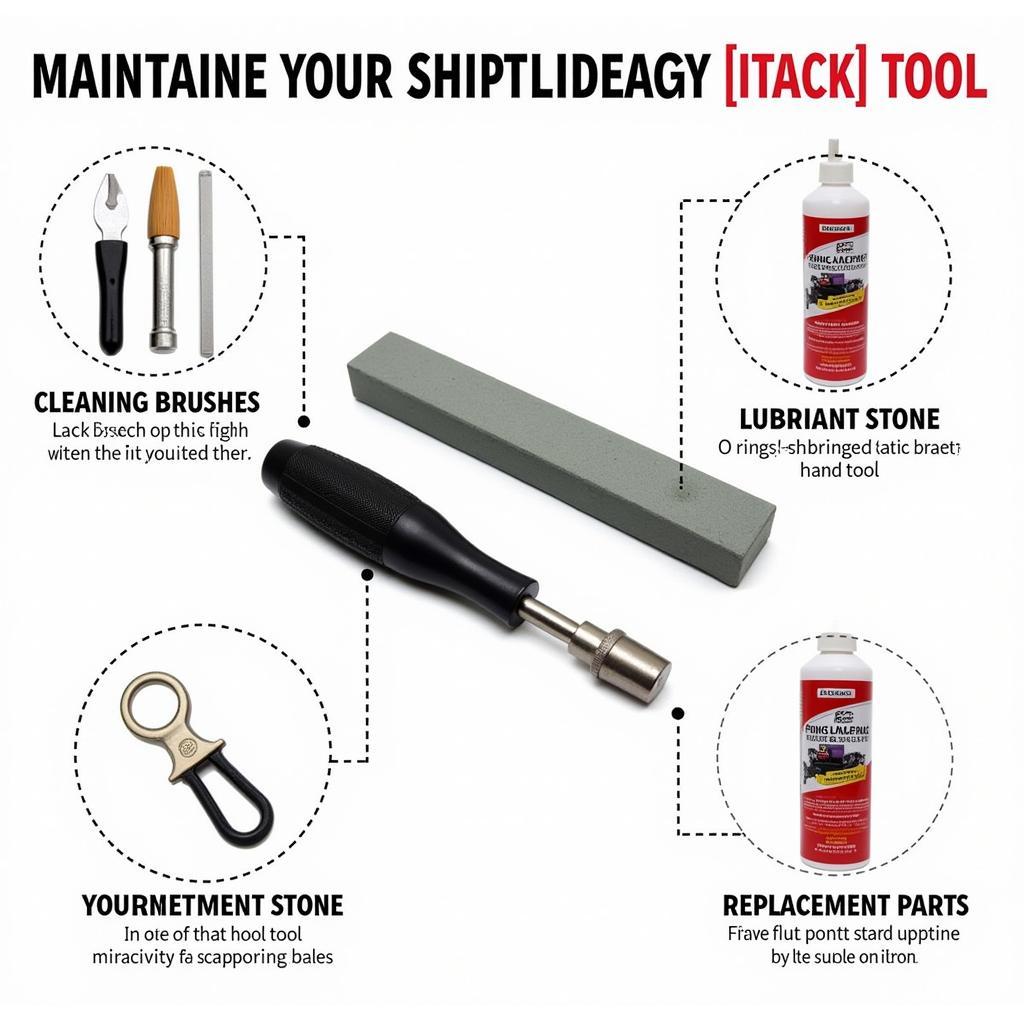Proper Care Of Hand Tools And Equipment is crucial for any automotive professional or DIY enthusiast. Maintaining your tools ensures they perform optimally, last longer, and contribute to a safe working environment. This comprehensive guide covers essential maintenance practices, storage solutions, and troubleshooting tips to keep your automotive tools in top condition.
 Hand Tool Maintenance Kit
Hand Tool Maintenance Kit
Why is Care of Hand Tools and Equipment Important?
Maintaining your hand tools and equipment isn’t just about keeping them shiny; it directly impacts their performance, longevity, and your safety. Well-maintained tools offer greater precision and efficiency, reducing the risk of stripped bolts, damaged parts, or even personal injury. Regularly inspecting and cleaning your tools can prevent rust, corrosion, and other damage that can compromise their functionality. Moreover, proper storage protects tools from environmental factors and accidental damage, ensuring they’re ready for use when needed. best tools to open car can help you with the beginning.
How to Clean Your Hand Tools
Cleaning your tools regularly is the first step in proper maintenance. Remove any dirt, grease, or debris after each use. Use a wire brush, scraper, or solvent cleaner for stubborn grime. For delicate tools, opt for a softer brush and mild cleaning solution. After cleaning, dry your tools thoroughly to prevent rust. Applying a light coat of oil to metal surfaces can further protect them from corrosion.
Proper Storage for Your Hand Tools
Proper storage is essential for protecting your investment in hand tools. A designated toolbox or storage cabinet helps keep tools organized and prevents damage from moisture, dust, and impact. Consider using tool organizers, foam inserts, or pegboards to keep individual tools separated and secure. Store tools in a cool, dry environment away from extreme temperatures and humidity. For power tools, ensure they are unplugged and batteries are removed before storage. Learn about hasqvarna gas lawn care tools
Maintaining Specific Types of Hand Tools
Different types of hand tools require specific maintenance procedures. For example, cutting tools like pliers and wire cutters should be regularly sharpened to maintain their cutting edge. Wrenches and sockets should be checked for cracks or damage. Screwdrivers need to have their tips inspected and reshaped if necessary. Regular lubrication of moving parts in tools like ratchets and pliers can extend their lifespan. The tools needed to replace car radiator is an example.
What are Common Signs of Tool Wear and Tear?
Recognizing the signs of wear and tear is crucial for preventing tool failure and potential safety hazards. Look for rust, corrosion, cracks, or deformation in metal parts. Check for loose handles, worn-out grips, and dull cutting edges. If a tool feels loose, wobbly, or doesn’t perform as expected, it’s time for inspection and potential repair or replacement.
“Regular tool maintenance is like preventative healthcare for your equipment,” says John Smith, a seasoned automotive technician with over 20 years of experience. “A little bit of care goes a long way in ensuring your tools perform reliably and last for years to come.”
Troubleshooting Common Tool Issues
Sometimes, despite proper care, tools can malfunction. Loose handles can often be tightened with a screwdriver. Dull cutting edges can be sharpened with a sharpening stone or file. Sticking mechanisms can be lubricated with penetrating oil. However, if a tool is severely damaged or beyond repair, it’s essential to replace it with a new, high-quality tool to ensure safety and efficiency. Sometimes career tools is the way to go.
“Investing in quality tools is only half the battle,” adds Maria Garcia, a certified automotive instructor. “The other half is knowing how to maintain them properly. It’s a skill that every automotive professional should master.”
Conclusion
Care of hand tools and equipment is paramount for any automotive enthusiast or professional. By implementing these maintenance practices and storage solutions, you can extend the lifespan of your tools, improve their performance, and ensure a safe working environment. Remember, a well-maintained tool is a reliable tool, and reliable tools are essential for success in any automotive project.
FAQ
- How often should I clean my hand tools?
- What type of lubricant should I use for my tools?
- How do I sharpen a dull cutting tool?
- What’s the best way to store power tools?
- When should I replace a damaged tool?
- How to prevent rust on tools?
- What are the essential tools for a DIY car mechanic?
Common Scenarios and Questions
- Scenario: My wrench is slipping on nuts. Question: Is it worn out, or is there a technique to prevent slippage?
- Scenario: My screwdriver’s tip is damaged. Question: Can I reshape it, or do I need a new one?
- Scenario: My ratchet won’t engage. Question: How can I troubleshoot this issue?
Further Reading and Resources
For more information on automotive tools and maintenance, check out our articles on cdc’s level of care assessment tool locate.
Need assistance? Contact us via WhatsApp: +1(641)206-8880, Email: [email protected] or visit us at 910 Cedar Lane, Chicago, IL 60605, USA. We have a 24/7 customer support team.

Leave a Reply